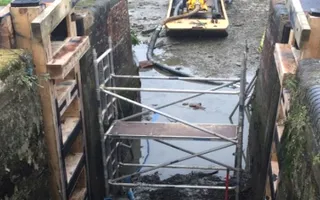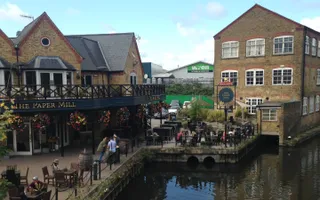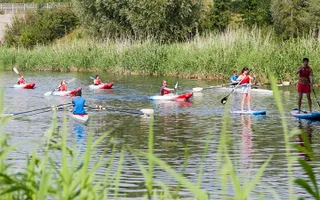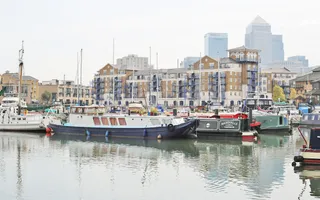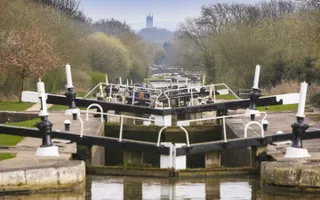The Grand Union Canal links London to Birmingham, passing through rolling countryside, industrial towns and quaint villages. It's our longest canal, and helps thousands to live healthier, happier lives.
The history
Competition from the railways and the narrow size of its locks meant that this mammoth waterway had to fight hard to survive in the early 20th Century.
The word Union offers a clue to the heritage of this canal. The Grand Union Canal was never constructed as an entity, but is the result of amalgamations between 1894 and 1929 of several independent waterways — the oldest being the navigations around the River Soar in Leicestershire, the longest the Grand Junction Canal from Braunston to the River Thames.
The term ‘Grand Union' is now generally taken to mean the canal from the Thames at Brentford to the junction with the Digbeth Branch in Birmingham.
Grand Junction Canal
The Grand Junction Canal was built to improve the communications between Birmingham and the Midlands and London. It received its Act in 1793 and was fully opened in 1805. Its major engineering works were the two long tunnels at Blisworth and Braunston, and the long and deep cutting at Tring summit.
Branches added:
Although the Grand Junction was built as a broad canal and could take boats 14ft wide, at its northern end it joined the narrow Oxford Canal and the canals which continued the line to Birmingham were also narrow. In practice, therefore, it was generally used only by narrow boats, except at the London end.
The canal had water supply problems, especially for the summit between Marsworth and Tring. A navigable feeder was made to Wendover (1797) and several reservoirs with pumping engines built near the junction. Over the years, back-pumping was introduced at many of the locks.
The advent of the railways forced the waterways to adapt in order to survive. The duplication of locks at Stoke Bruerne and the ascent of the northern slope of the Chilterns is an early example of attempts to speed up traffic on the Grand Junction. Despite reductions in tolls because of railway competition, the canal stayed profitable.
North of Napton Junction
This section was built by two separate companies, the Warwick & Napton Canal and the Warwick & Birmingham Canal. Both were designed for narrow boats and were completed in 1800.
They shared many committee members and worked closely together, enjoying a profit until railway competition arrived in 1838. The weight of freight carried dropped by nearly a third in a few years, then stayed reasonably steady for several decades. However, tolls were greatly reduced, and receipts in the 1860s were less than a third of what they had been in the 1830s.
Amalgamation
In 1894 the Grand Junction bought the canals which now comprise the ‘Leicester Line', then in 1929 the Regent's, Grand Junction and the two Warwick Canals merged and were renamed as the ‘Grand Union Canal'.
The new company embarked on a large-scale modernisation programme, largely financed by government loans, with the aim of enabling broad-beamed boats to work between London and Birmingham. Long lengths were dredged and strengthened with concrete bank protection. Bridges were widened or replaced, and the narrow locks between Braunston and Birmingham were replaced with broad locks (the remains of most of the old locks can be seen alongside their larger replacements). The canal company also embarked on an programme of building a large fleet of narrow boats but it struggled to find crews to man them.
The ambitious scheme was completed in 1937 but much of the canal remained too shallow for broad boats to pass each other, and of course broad boats could not pass in the tunnels. However, narrow boats could now easily and quickly work in pairs. Traffic increased in the short term, but after the war the long-term downwards trend was relentless as canalside factories ceased using coal as a fuel or obtained it from other sources.
The Grand Union today
Today, the Grand Union Canal is alive with pleasure boats, walkers, cycle trails, anglers and day trippers. As well as the impressive mainline, many smaller branches make great diversions if you have time to explore. The longest of these is the Leicester Line with its own brand at Welford. Others include the Aylesbury Arm, Market Harborough Arm and Northampton Arm.
The Paddington Arm runs through a lively and attractive area of West London, full of bars, restaurants, shops, Middle Eastern cafes, juice bars and a terraced canalside seating area at Sheldon Square.
The Slough Arm is an unexpectedly green and rural bit of canal, passing through the pretty town of Iver. It is a great place to escape the crowds on the nearby London waterways.
Where does the water come from?
Crick
The water at Crick comes from below Watford Locks, which may come from as far as Milton Keynes, Oxford or Birmingham, and from reservoirs on the Leicester Summit. The Leicester Summit is the 23 mile lock-free stretch of the Grand Union Canal from Watford Locks to Foxton Locks. Water is pumped up Watford Locks. Feeders (diverted streams) also bring smaller amounts of water into the system.
Each year over4000 lockfuls, which is 600 million litres of water, pass down Watford Locks and over 1000 million litres are pumped up at a cost of about £12,000.
Water from canal from the River Avon feeds directly into the canal from November to May, to maintain river flow in the summer.
Knowle Locks
The water at Knowle Locks, on the Grand Union Canal in the West Midlands, comes primarily from Olton Reservoir, which holds 320 million litres of water, and a backpump in central Birmingham. Reservoir water is gravity-fed to the canal. This is much less expensive than pumping water. Feeders from diverted streams also bring smaller amounts of water into the system.
The pump at bowyer Street lifts water up past Camp Hill Locks, from the Digbeth Pound to the Ten Mile Pound to the Ten Mile Pound on the Grand Union Canal. The water pumped up at Bowyer Stret can either come from the Birmingham Level or the groundwater pump at Perry Barr.
Knowle Locks are used around 1,300 time a year.




